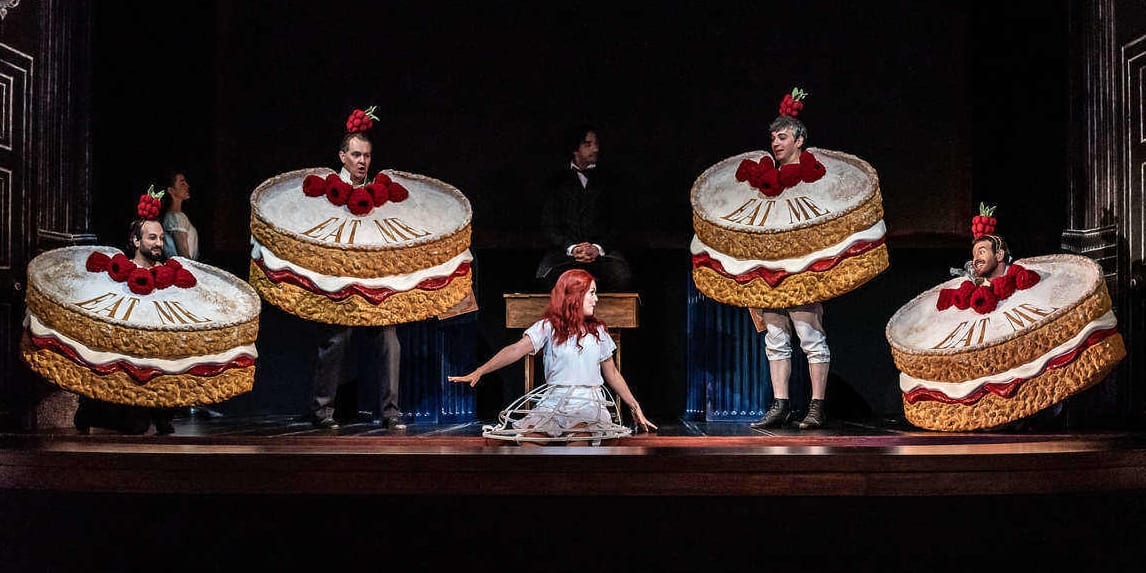Alice’s Adventures Under Ground saps the wonder out of Wonderland.
In striving to produce a frenzied and maddening performance that matches the impenetrable nonsense of Lewis Carroll’s work, Gerald Barry has instead created a show which, from the off, struggles to keep up with itself and whilst I would love to describe this as a clever nod towards the White Rabbit’s lost sense of time keeping, that would just be misleading – it feels out of sync, out of tempo and in a constant panic to keep up with its unachievable relentlessness. Now, as composers such as Sondheim have proven, high density lyrics are possible to pull off and, when done well, leave an audience in awed disbelief. There is nothing so clever at play here; repeating the same line, over and over and over again, in the same scale, in the same manner is monotonous and dull. I understand that this focus on repetition is intended to create a crazed environment and to draw the audience into the disillusionment felt by Alice, but it does not achieve this. There may be sense to Carroll’s nonsense, but there is no hidden sense to Barry’s overly repetitive libretto.
This does not, however, reflect on the standard of the cast: maintaining this incredibly demanding score is an impressive feat, with Claudia Boyle and Clare Presland delivering particularly outstanding performances. It would not be an exaggeration to say that Alice (Boyle) spends the majority of her stage time lingering high upon a top C– she is a truly refined and beautiful soprano. Unfortunately, the cast are similarly implicated by the libretto and they struggle to endure the speed that the score demands. The individual lyrics are frequently rendered inaudible and the long passages of repetitive sequences leave the individual performers in a state akin to running a 5km whilst attempting to hold a conversation – a thing I understand to be impossible. Alice’s Adventures Under Ground shines brightest when the four men (Sam Furness, Peter Tantsits, Mark Stone and Joshua Bloom) are on stage together, humorously personifying the cakes and bottles that are electrifyingly brought to life by the stunning costume team.
In fact, the props, costumes and scenery save this opera. In keeping with its literary history, the stage acts as a sort of popup book and puppetry scene with the performers excellently managing this fantastical characterisation. Alice’s Adventures Under Ground is almost pantomime-esque in the sheer size, colour and quantity of various costumes in use which, in turn, infuses some much needed vibrancy!
Carroll’s literature is, by definition, nonsensical entertainment; it is funny, chaotic and frustratingly brilliant. Besides a scattering of laughter, Alice’s Adventures Under Ground simply does not match this energy. Aside from The Jabberwocky scene, the whole performance feels flat and lacks any purposeful trajectory – the charming bafflement of Carroll’s Wonderland is translated into a jarring attempt at nonsense and humour.
All in all, it is baffling how an opera inspired by Lewis Carroll can be boiled down to an hour long performance that still leaves you checking the time. There are, without a doubt, flashes of brilliance and the vocal ability of the cast cannot be questioned but the standard of the production as a whole is not consistent. In its amalgamation of languages, styles, characters and dance it certainly provides a crash course in opera for younger viewers but, even then, I would sooner recommend the traditional works of Verdi and Puccini to the young opera enthusiast.
Once again, this has proven the age old aphorism that the book is always better than the film or, in this case, the opera.

